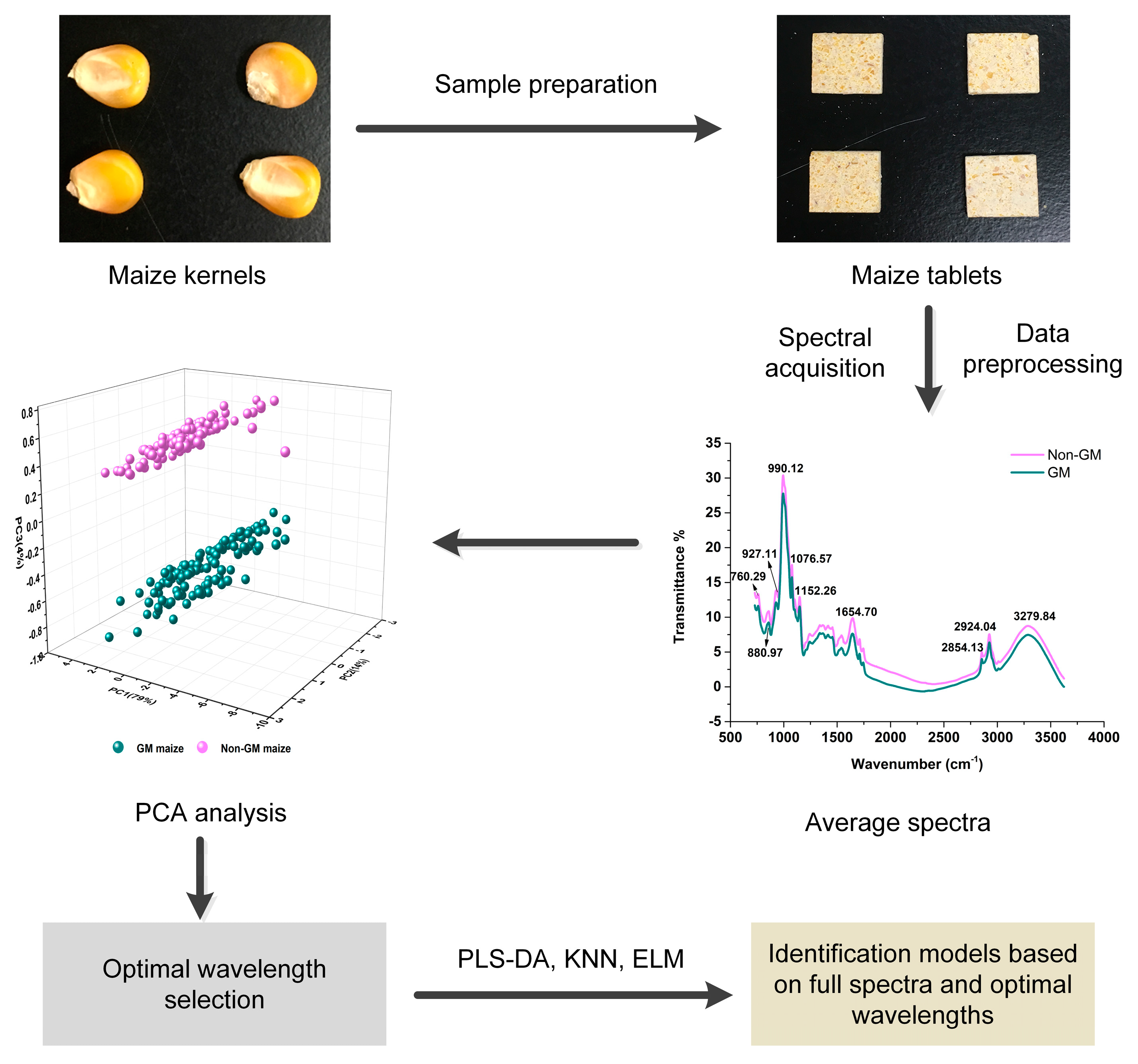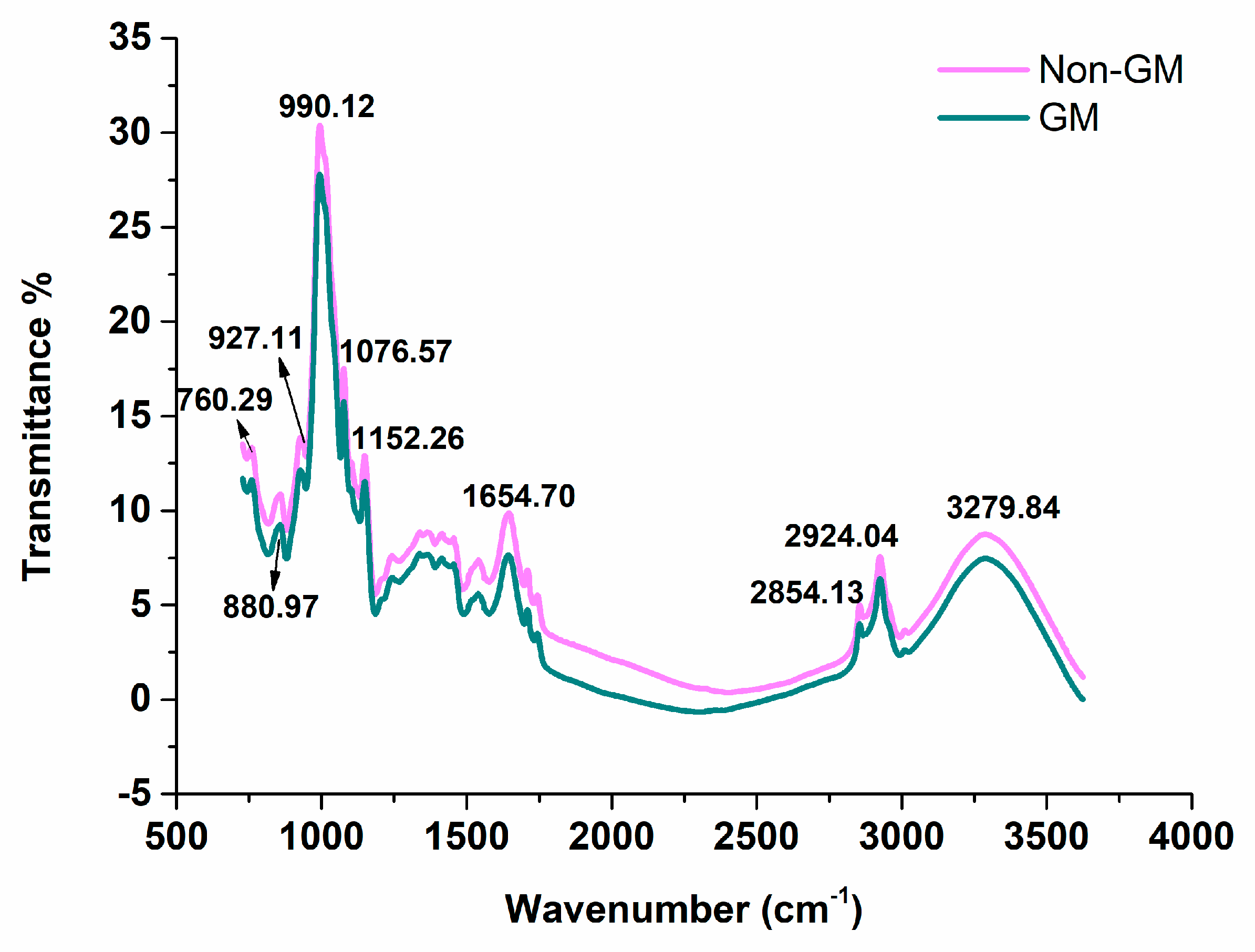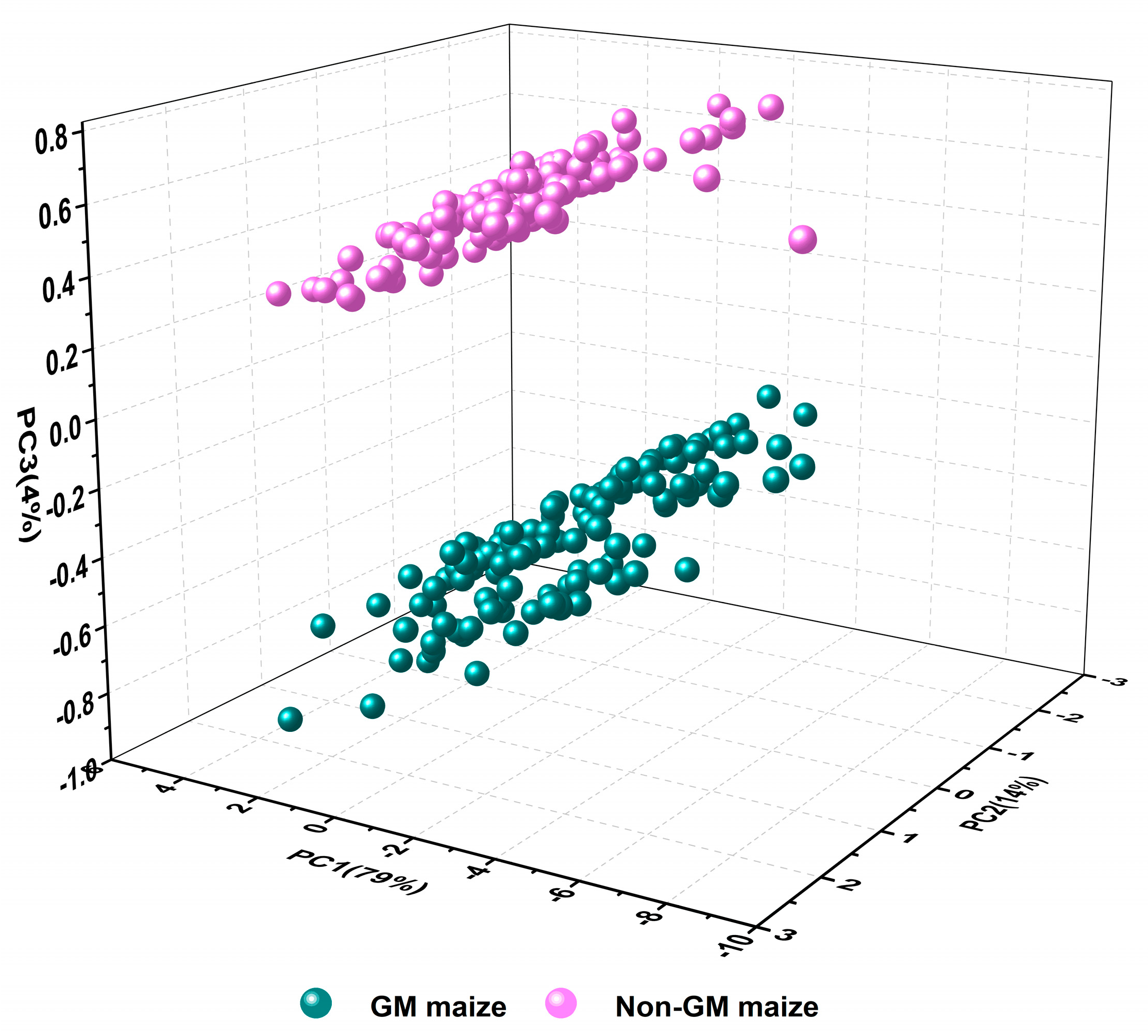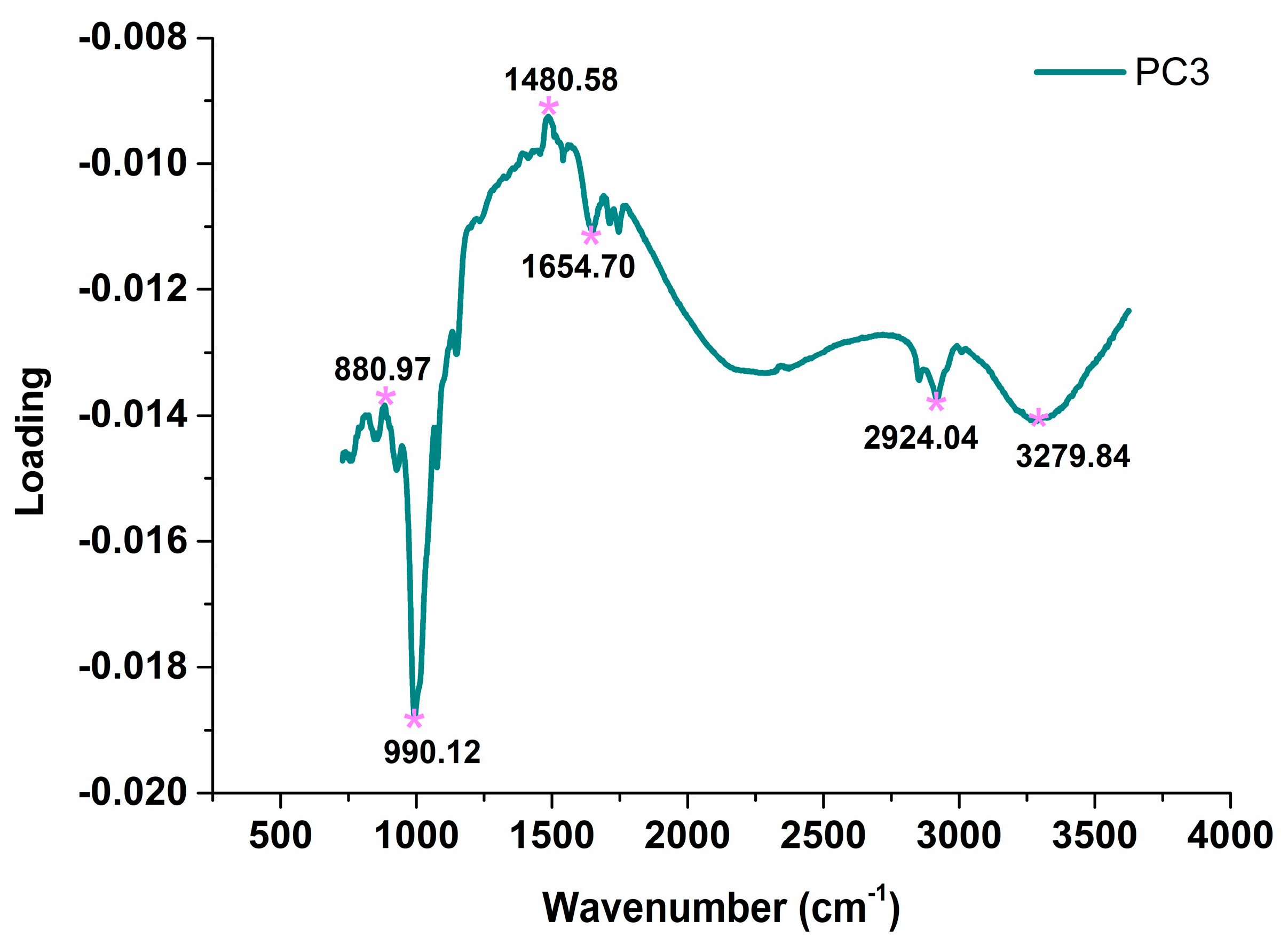Rapid Identification of Insecticide- and Herbicide-Tolerant Genetically Modified Maize Using Mid-Infrared Spectroscopy
Abstract
1. Introduction
2. Materials and Methods
2.1. Analytical Procedure for the Identification of Maize
2.2. Maize Samples
2.3. Spectral Acquisition
2.4. Data Analysis
2.4.1. Data Preprocessing
2.4.2. Chemometric Methods
2.5. Software Tools
3. Results
3.1. Spectral Analysis
3.2. PCA Analysis
3.3. Variable Selection
3.4. Classification Models Based on Optimal Wavelengths and Full Spectra
4. Conclusions
Author Contributions
Funding
Data Availability Statement
Conflicts of Interest
References
- Caradus, J.R. Intended and unintended consequences of genetically modified crops–myth, fact and/or manageable outcomes? N. Z. J. Agric. Res. 2022, 1–101. [Google Scholar] [CrossRef]
- van Esse, H.P.; Reuber, T.L.; van der Does, D. Genetic modification to improve disease resistance in crops. New Phytol. 2020, 225, 70–86. [Google Scholar] [CrossRef] [PubMed]
- Beckie, H.J.; Ashworth, M.B.; Flower, K.C. Herbicide Resistance Management: Recent Developments and Trends. Plants 2019, 8, 161. [Google Scholar] [CrossRef]
- Kaundun, S.S. Syngenta’s contribution to herbicide resistance research and management. Pest Manag. Sci. 2021, 77, 1564–1571. [Google Scholar] [CrossRef] [PubMed]
- Sohn, S.I.; Pandian, S.; Oh, Y.J.; Zaukuu, J.Z.; Kang, H.J.; Ryu, T.H.; Cho, W.S.; Cho, Y.S.; Shin, E.K.; Cho, B.K. An Overview of Near Infrared Spectroscopy and Its Applications in the Detection of Genetically Modified Organisms. Int. J. Mol. Sci. 2021, 22, 9940. [Google Scholar] [CrossRef] [PubMed]
- Qian, C.; Wang, R.; Wu, H.; Ping, J.; Wu, J. Recent advances in emerging DNA-based methods for genetically modified organisms (GMOs) rapid detection. TrAC Trends Anal. Chem. 2018, 109, 19–31. [Google Scholar] [CrossRef]
- Demeke, T.; Dobnik, D. Critical assessment of digital PCR for the detection and quantification of genetically modified organisms. Anal. Bioanal. Chem. 2018, 410, 4039–4050. [Google Scholar] [CrossRef]
- Rocha, P.D.; Medeiros, E.P.; Silva, C.S.; da Silva Simoes, S. Chemometric strategies for near infrared hyperspectral imaging analysis: Classification of cotton seed genotypes. Anal. Methods 2021, 13, 5065–5074. [Google Scholar] [CrossRef]
- Wei, X.; Zheng, W.; Zhu, S.; Zhou, S.; Wu, W.; Xie, Z. Application of terahertz spectrum and interval partial least squares method in the identification of genetically modified soybeans. Spectrochimica acta. Spectrochim. Acta A Mol. Biomol. 2020, 238, 118453. [Google Scholar] [CrossRef]
- Pereira, C.G.; Luiz, L.V.; Bell, M.J.; Anjos, V. Near And Mid Infrared Spectroscopy To Assess Milk Products Quality: A Review Of Recent Applications. J. Dairy Res. Tech. 2020, 3, 1–10. [Google Scholar]
- Aykas, D.P.; Rodrigues Borba, K.; Rodriguez-Saona, L.E. Non-Destructive Quality Assessment of Tomato Paste by Using Portable Mid-Infrared Spectroscopy and Multivariate Analysis. Foods 2020, 9, 1300. [Google Scholar] [CrossRef] [PubMed]
- Zuk, M.; Dyminska, L.; Kulma, A.; Boba, A.; Prescha, A.; Szopa, J.; Maczka, M.; Zajac, A.; Szoltysek, K.; Hanuza, J. IR and Raman studies of oil and seedcake extracts from natural and genetically modified flax seeds. Spectrochim. Acta A Mol. Biomol. Spectrosc. 2011, 78, 1080–1089. [Google Scholar] [CrossRef] [PubMed]
- Tiplady, K.M.; Lopdell, T.J.; Littlejohn, M.D.; Garrick, D.J. The evolving role of Fourier-transform mid-infrared spectroscopy in genetic improvement of dairy cattle. J. Anim. Sci. Biotechnol. 2020, 11, 39. [Google Scholar] [CrossRef] [PubMed]
- Bec, K.B.; Grabska, J.; Huck, C.W. Biomolecular and bioanalytical applications of infrared spectroscopy—A review. Anal. Chim. Acta 2020, 1133, 150–177. [Google Scholar] [CrossRef]
- Feng, X.; Zhao, Y.; Zhang, C.; Cheng, P.; He, Y. Discrimination of Transgenic Maize Kernel Using NIR Hyperspectral Imaging and Multivariate Data Analysis. Sensors 2017, 17, 1894. [Google Scholar] [CrossRef]
- He, Y.; Zhao, Y.; Zhang, C.; Sun, C.; Li, X.; Zhao, Y.; Zhang, C.; Sun, C.; Li, X. Determination of ß-Carotene and Lutein in Green Tea Using Fourier Transform Infrared Spectroscopy. Trans. ASABE 2019, 62, 75–81. [Google Scholar] [CrossRef]
- Zhang, C.; Wang, C.; Liu, F.; He, Y. Mid-Infrared Spectroscopy for Coffee Variety Identification: Comparison of Pattern Recognition Methods. J. Mol. Spectrosc. 2016, 2016, 7927286. [Google Scholar] [CrossRef]
- Zhang, C.; Zhou, L.; Zhao, Y.; Zhu, S.; Liu, F.; He, Y. Noise reduction in the spectral domain of hyperspectral images using denoising autoencoder methods. Chemom. Intell. Lab. Syst. 2020, 203, 104063. [Google Scholar] [CrossRef]
- Wang, L.; Wang, R. Determination of soil pH from Vis-NIR spectroscopy by extreme learning machine and variable selection: A case study in lime concretion black soil. Spectrochim. Acta A Mol. Biomol. Spectrosc. 2022, 283, 121707. [Google Scholar] [CrossRef]
- Xia, K.; Xia, S.; Shen, Q.; Yang, B.; Song, Q.; Xu, Y.; Zhang, S.; Zhou, X.; Zhou, Y. Moisture spectral characteristics and hyperspectral inversion of fly ash-filled reconstructed soil. Spectrochim. Acta A Mol. Biomol. Spectrosc. 2021, 253, 119590. [Google Scholar] [CrossRef]
- Zhang, L.; Huang, X.; Fan, X.; He, W.; Yang, C.; Wang, C. Rapid fingerprinting technology of heavy oil spill by mid-infrared spectroscopy. Environ. Technol. 2021, 42, 270–278. [Google Scholar] [CrossRef] [PubMed]
- Liu, X.; Feng, X.; Liu, F.; Peng, J.; He, Y. Rapid Identification of Genetically Modified Maize Using Laser-Induced Breakdown Spectroscopy. Food Bioprocess Technol. 2018, 12, 347–357. [Google Scholar] [CrossRef]
- Kaushal, S.; Nayi, P.; Rahadian, D.; Chen, H.-H. Applications of Electronic Nose Coupled with Statistical and Intelligent Pattern Recognition Techniques for Monitoring Tea Quality: A Review. Agriculture 2022, 12, 1359. [Google Scholar] [CrossRef]
- Khodabakhshian, R.; Bayati, M.R.; Emadi, B. An evaluation of IR spectroscopy for authentication of adulterated turmeric powder using pattern recognition. Food Chem. 2021, 364, 130406. [Google Scholar] [CrossRef]
- Jimenez-Carvelo, A.M.; Gonzalez-Casado, A.; Bagur-Gonzalez, M.G.; Cuadros-Rodriguez, L. Alternative data mining/machine learning methods for the analytical evaluation of food quality and authenticity—A review. Food Res. Int. 2019, 122, 25–39. [Google Scholar] [CrossRef]
- Al-Hashedi, K.G.; Magalingam, P. Financial fraud detection applying data mining techniques: A comprehensive review from 2009 to 2019. Comput. Sci. Rev. 2021, 40, 100402. [Google Scholar] [CrossRef]
- Cocco Mariani, V.; Hennings Och, S.; dos Santos Coelho, L.; Domingues, E. Pressure prediction of a spark ignition single cylinder engine using optimized extreme learning machine models. Appl. Energy 2019, 249, 204–221. [Google Scholar] [CrossRef]
- Abbas, O.; Compère, G.; Larondelle, Y.; Pompeu, D.; Rogez, H.; Baeten, V. Phenolic compound explorer: A mid-infrared spectroscopy database. Vib. Spectrosc. 2017, 92, 111–118. [Google Scholar] [CrossRef]
- Tewari, J.C.; Irudayaraj, J.M. Floral classification of honey using mid-infrared spectroscopy and surface acoustic wave based z-Nose sensor. J. Agric. Food. Chem. 2005, 53, 6955–6966. [Google Scholar] [CrossRef]
- Hazarika, S.; Hebb, R.L.; Rizvi, S.S.H. Prediction of Ripening Stage of Cameo Apple Using Fourier-Transform Infrared Spectroscopy. Int. J. Fruit Sci. 2017, 18, 188–198. [Google Scholar] [CrossRef]
- Via, B.; Fasina, O.; Pan, H. Assessment of pine biomass density through mid-infrared spectroscopy and multivariate modeling. BioResources 2013, 6, 807–822. [Google Scholar] [CrossRef]
- Matouke, M.M. FTIR study of the binary effect of titanium dioxide nanoparticles (nTiO2) and copper (Cu2+) on the biochemical constituents of liver tissues of catfish (Clarias gariepinus). Toxicol. Rep. 2019, 6, 1061–1070. [Google Scholar] [CrossRef] [PubMed]
- San-Blas, E.; Cubillan, N.; Guerra, M.; Portillo, E.; Esteves, I. Characterization of Xenorhabdus and Photorhabdus bacteria by Fourier transform mid-infrared spectroscopy with attenuated total reflection (FT-IR/ATR). Spectrochim. Acta A Mol. Biomol. Spectrosc. 2012, 93, 58–62. [Google Scholar] [CrossRef] [PubMed]
- Rayan, A.M.; Abbott, L.C. Compositional analysis of genetically modified corn events (NK603, MON88017xMON810 and MON89034xMON88017) compared to conventional corn. Food Chem. 2015, 176, 99–105. [Google Scholar] [CrossRef]
- Agapito-Tenfen, S.; Guerra, M.; Wikmark, O.-G.; Nodari, R. Comparative Proteomic Analysis of Genetically Modified Maize Grown under Different Agroecosystems Conditions in Brazil. Proteome Sci. 2013, 11, 46. [Google Scholar] [CrossRef]
- Tan, Y.; Yi, X.; Wang, L.; Peng, C.; Sun, Y.; Wang, D.; Zhang, J.; Guo, A.; Wang, X. Comparative Proteomics of Leaves from Phytase-Transgenic Maize and Its Non-transgenic Isogenic Variety. Front. Plant Sci. 2016, 7, 1211. [Google Scholar] [CrossRef]
- Fornale, S.; Capellades, M.; Encina, A.; Wang, K.; Irar, S.; Lapierre, C.; Ruel, K.; Joseleau, J.P.; Berenguer, J.; Puigdomenech, P.; et al. Altered lignin biosynthesis improves cellulosic bioethanol production in transgenic maize plants down-regulated for cinnamyl alcohol dehydrogenase. Mol. Plant 2012, 5, 817–830. [Google Scholar] [CrossRef]
- Tonolini, M.; Sorensen, K.M.; Skou, P.B.; Ray, C.; Engelsen, S.B. Prediction of alpha-Lactalbumin and beta-Lactoglobulin Composition of Aqueous Whey Solutions Using Fourier Transform Mid-Infrared Spectroscopy and Near-Infrared Spectroscopy. Appl. Spectrosc. 2021, 75, 718–727. [Google Scholar] [CrossRef]
- Xia, Y.; Ugarte, C.M.; Guan, K.; Pentrak, M.; Wander, M.M. Developing Near- and Mid-Infrared Spectroscopy Analysis Methods for Rapid Assessment of Soil Quality in Illinois. Soil Sci. Soc. Am. J. 2018, 82, 1415–1427. [Google Scholar] [CrossRef]
- Cengiz, M.F.; Durak, M.Z. Rapid detection of sucrose adulteration in honey using Fourier transform infrared spectroscopy. Spectrosc. Lett. 2019, 52, 267–273. [Google Scholar] [CrossRef]
- Daoud, S.; Bou-Maroun, E.; Waschatko, G.; Horemans, B.; Mestdagh, R.; Billecke, N.; Cayot, P. Detection of Lipid Oxidation in Infant Formulas: Application of Infrared Spectroscopy to Complex Food Systems. Foods 2020, 9, 1432. [Google Scholar] [CrossRef] [PubMed]





| Wavelength (cm−1) | Assignment | Average Spectra Transmittance % (GM Maize) | Average Spectra Transmittance % (non-GM Maize) | p-Value |
|---|---|---|---|---|
| 730.41 | deformation vibrations of the C-H group [28] | 11.79 ± 2.89 | 13.06 ± 4.56 | 1.56 × 10−2 |
| 776.69 | deformation vibrations of the C-H group [28] | 9.85 ± 2.64 | 11.19 ± 4.32 | 6.51 × 10−3 |
| 811.40 | deformation vibrations of the C-H group [28] | 7.82 ± 2.41 | 9.24 ± 4.04 | 2.02 × 10−3 |
| 992.68 | stretching of C-O in the C-OH group [40] | 28.77 ± 6.08 | 29.35 ± 8.59 | 5.76 × 10−1 |
| 1063.07 | C-O stretching vibrations [28] | 13.31 ± 2.87 | 14.41 ± 4.43 | 3.52 × 10−2 |
| 1171.54 | CO-O-C asymmetric stretching vibrations [31] | 5.71 ± 1.78 | 6.87 ± 3.15 | 1.30 × 10−3 |
| 1477.69 | C=C stretching vibrations [28] | 4.85 ± 1.43 | 6.09 ± 2.62 | 2.46 × 10−5 |
| 1559.17 | C=C stretching vibrations [28] | 5.05 ± 1.50 | 6.43 ± 2.70 | 5.82 × 10−6 |
| 1615.09 | aromatic C=C stretching vibrations [28] | 6.19 ± 1.67 | 7.74 ± 2.85 | 2.07 × 10−6 |
| 1653.18 | stretching vibrations of C=O group [31] | 7.66 ± 1.83 | 9.25 ± 3.03 | 6.34 × 10−6 |
| 1745.74 | vibrations of the carbonyl group (-C=O) [41] | 3.63 ± 1.80 | 5.32 ± 3.10 | 1.73 × 10−6 |
| 3320.34 | O-H stretching vibrations [30] | 7.19 ± 2.17 | 8.65 ± 3.82 | 7.25 × 10−4 |
| 3618.77 | O-H stretching vibrations [30] | 0.93 ± 0.45 | 0.94 ± 0.66 | 9.24 × 10−1 |
| Input Variables | Discrimination Model | Calibration Identification Rate | Prediction Identification Rate |
|---|---|---|---|
| Full spectra | PLS-DA | 90% | 80% |
| KNN | 95.00% | 93.75% | |
| ELM | 100.00% | 98.75% | |
| SPA | PLS-DA | 98.13% | 96.25% |
| KNN | 79.38% | 77.50% | |
| ELM | 100.00% | 98.75% |
Disclaimer/Publisher’s Note: The statements, opinions and data contained in all publications are solely those of the individual author(s) and contributor(s) and not of MDPI and/or the editor(s). MDPI and/or the editor(s) disclaim responsibility for any injury to people or property resulting from any ideas, methods, instructions or products referred to in the content. |
© 2022 by the authors. Licensee MDPI, Basel, Switzerland. This article is an open access article distributed under the terms and conditions of the Creative Commons Attribution (CC BY) license (https://creativecommons.org/licenses/by/4.0/).
Share and Cite
Liu, X.; Yu, Y.; Bai, X.; Li, X.; Zhang, J.; Wang, D. Rapid Identification of Insecticide- and Herbicide-Tolerant Genetically Modified Maize Using Mid-Infrared Spectroscopy. Processes 2023, 11, 90. https://doi.org/10.3390/pr11010090
Liu X, Yu Y, Bai X, Li X, Zhang J, Wang D. Rapid Identification of Insecticide- and Herbicide-Tolerant Genetically Modified Maize Using Mid-Infrared Spectroscopy. Processes. 2023; 11(1):90. https://doi.org/10.3390/pr11010090
Chicago/Turabian StyleLiu, Xiaodan, Yonghui Yu, Xiulin Bai, Xiaolong Li, Jun Zhang, and Dun Wang. 2023. "Rapid Identification of Insecticide- and Herbicide-Tolerant Genetically Modified Maize Using Mid-Infrared Spectroscopy" Processes 11, no. 1: 90. https://doi.org/10.3390/pr11010090
APA StyleLiu, X., Yu, Y., Bai, X., Li, X., Zhang, J., & Wang, D. (2023). Rapid Identification of Insecticide- and Herbicide-Tolerant Genetically Modified Maize Using Mid-Infrared Spectroscopy. Processes, 11(1), 90. https://doi.org/10.3390/pr11010090







